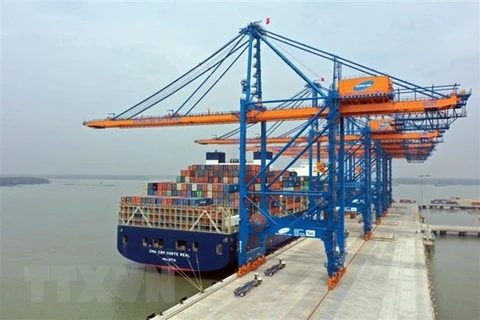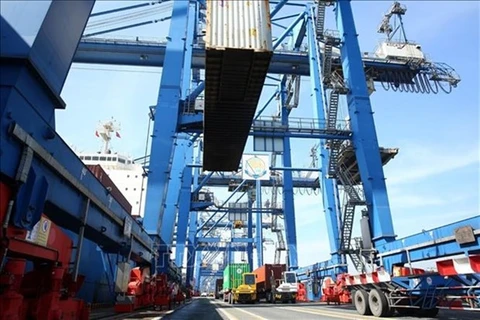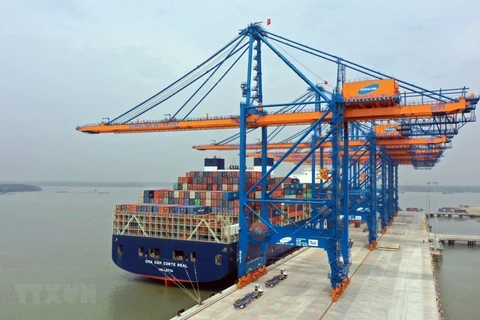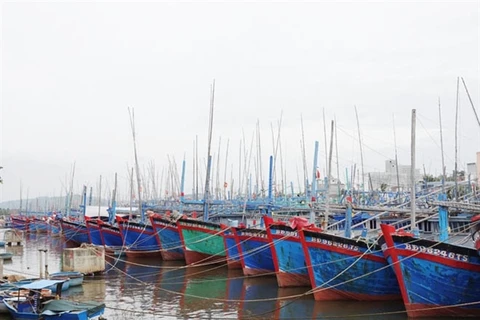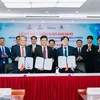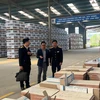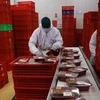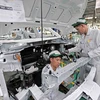Hanoi (VNA) – The central region is racing to upgrade their seaports to meet high demand on transporting goods, especially to serve container ships, reported Dau Tu (Investment) newspaper.
In its adjusted planning to 2020 with a vision to 2030, the Dung Quat Port Complex in the central province of Quang Ngai has been designed with 14 ports to become a modern and large-scale one that can serve both large barges and container ships.
However, after more than ten years, it currently has only eight ports in operation, three general ports and five specialised ports.
Of these, only the Hoa Phat Dung Quat port can receive vessels with a capacity of 150,000 - 200,000 tonnes and the rest can only handle those with a capacity of 50,000 - 70,000 tonnes.
Quang Ngai province currently has more than 20 enterprises involved in importing and exporting goods using container ships with around 6,500 containers per year. However, Dung Quat has no container port, forcing local exporters to transport their containers of export goods to Da Nang or neighbouring seaports in the central region.
Dang Van Minh, chairman of Quang Ngai Province’s People’s Committee, said most of the ports at Dung Quat Port Complex have operated at their full capacity, so they will not be able to meet the import and export needs of businesses in the long term. Therefore, fresh investment in ports is very necessary.
In nearby Binh Dinh province, the cargo throughput of Quy Nhon port skyrocketed from 4.5 million tonnes in 2010 to 9.1 million tonnes in 2019 and more than 12 million tonnes in 2020.
In nearby Binh Dinh province, the cargo throughput of Quy Nhon port skyrocketed from 4.5 million tonnes in 2010 to 9.1 million tonnes in 2019 and more than 12 million tonnes in 2020.
The port now handles 2,500 tonnes of goods per berth metre, more than five times higher than the designed capacity. Therefore, the upgrading of Quy Nhon port is extremely essential.
The Quy Nhon Port Joint Stock Company will start upgrading Quy Nhon Port’s wharf No 1 in August to ease the overloading at the port. The project will help to increase the port’s capacity in receiving ships up to 30,000 DWT ships.
In a recent document sent to the Ministry of Transport, voters in Phu Yen province proposed to invest in Bai Goc deep-water port and seaport logistics area in order to tap the local advantages to enhance the competitiveness and promote regional linkages, creating a driving force to attract large industrial and service projects to the Nam Phu Yen Economic Zone.
The Ministry of Transport has expressed its backing of the proposal.
Meanwhile, the Cam Ranh Port Joint Stock Company which operates Ba Ngoi port in Khanh Hoa province also suggested the port be upgraded in order to receive ships of up to 70,000 dead weight tonnes (DWT), according to provincial Department of Transport and Communications.
Nguyen Tan Tuan, Chairman of Khanh Hoa Provincial People's Committee said that the province has approved the proposal and is consulting the Ministry of Defence before submitting to the Prime Minister for approval./.
Meanwhile, the Cam Ranh Port Joint Stock Company which operates Ba Ngoi port in Khanh Hoa province also suggested the port be upgraded in order to receive ships of up to 70,000 dead weight tonnes (DWT), according to provincial Department of Transport and Communications.
Nguyen Tan Tuan, Chairman of Khanh Hoa Provincial People's Committee said that the province has approved the proposal and is consulting the Ministry of Defence before submitting to the Prime Minister for approval./.
VNA

